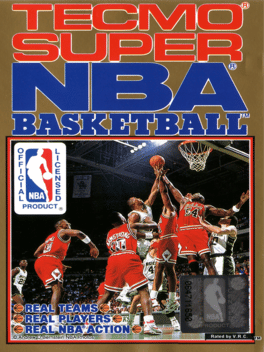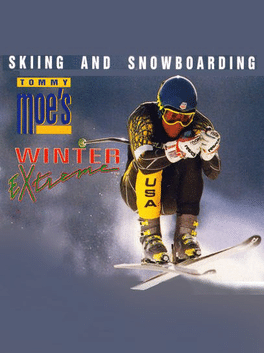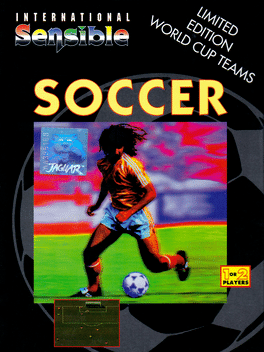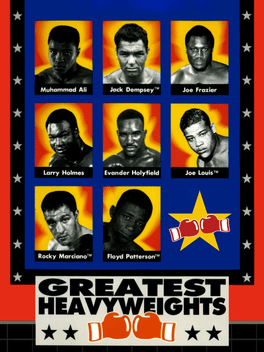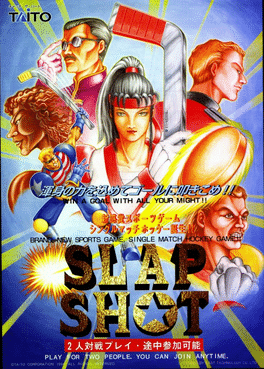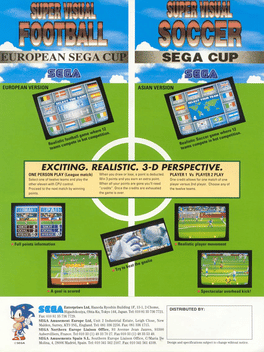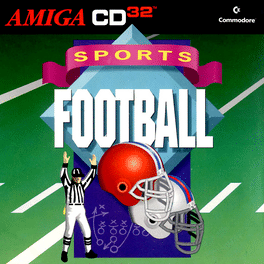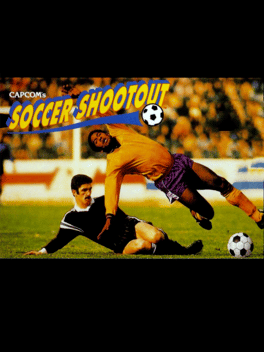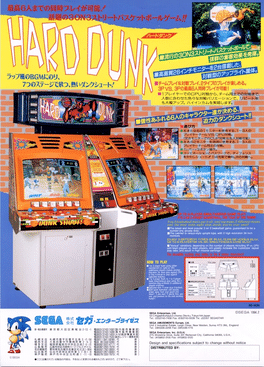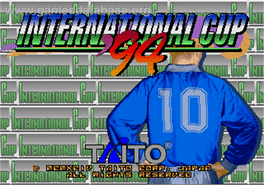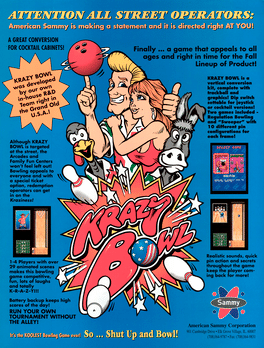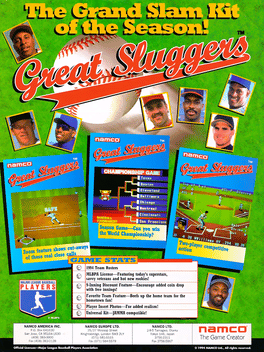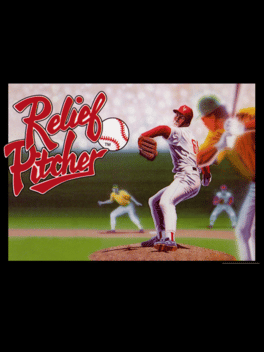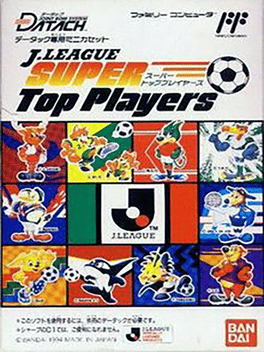New Mac Games - Page 189
-
Tecmo Super NBA Basketball
1994
star 6.9Tecmo Super NBA features real teams (all 27 contemporary teams) and a roster of real players (over 320). One or two players can compete in regular, reduced, or short seasons, or play an exhibition game. Though primarily horizontal scrolling, digitized speech and cinemas, along with a free throw point of view, add drama to the proceedings. Besides the expected elements of basketball (substitutions, penalties, steals and blocks, time-outs, overtime), Super NBA gives you the chance to call offensive plays and to program win/loss records. Has a battery to back-up season play. -
Tommy Moe's Winter Extreme: Skiing & Snowboarding
1994
In Winter Extreme, the player can partake in a series of skiing and snowboarding events including the Downhill where the player speeds down a course in order to finish the course as fast as possible in an allotted time by speeding through checkpoints. The Slalom has the same set-up where the player has to finish the course in an allotted time by passing through gates, but also has to contend with twists, turns and various other obstacles in the players path. The Giant Slalom is similar except for more obstacles and a longer path. -
J.League Winning Goal
1994
J.League Winning Goal is a soccer game released for the Game Boy and Family Computer that revolves around the J-League. There is an exhibition, a season mode, a playoff mode, and a practice mode. The object in the game is to win the championship so that the player's chosen team can be called the greatest team in all of Japan. -
International Sensible Soccer
1994
star 7Released to coincide with the 1994 World Cup, this version of Sensible Soccer was the first in the series to include national teams from outside Europe. The full World Cup tournament is featured, with players able to modify the selection of 24 participating teams—a notable option for English and French fans, as neither nation qualified for the tournament. This edition also introduced an on-screen referee for the first time in the series. Club team data was updated to reflect recent transfers and kit changes since the previous version. Gameplay remains consistent with earlier editions, using a top-down perspective, small player sprites, and a loose ball control system. -
Greatest Heavyweights
1994
Eight World Heavyweight Champs Answer the Bell in this ultimate showdown to decide who's #1! Muhammad Ali, Jack Dempsey, Joe Frazier, Larry Holmes, Evander Holyfield, Joe Louis, Rocky Marciano, and Floyd Patterson - all in their prime and looking for knockouts! Each Champion looks and boxes in their signature styles. It's Ali's speed against Marciano's power, Holmes' stinging jab versus Frazier's devastating hook! -
IMG International Tour Tennis
1994
Licensed by the International Management Group (IMG), this rare Electronic Arts venture into Tennis features 32 professional players (all male and licensed by the IMG) including Bjorn Borg, Marcelo Rios, Patrick Rafter and Yevgeni Kafelnikov in 15 tournaments with different surfaces. Game modes include exhibition, tour and tournament for both singles and doubles. Along the usual offering of lobs, volleys, passing shots, top spins and slashes, the player can leave player movement to the console, and just focus on hitting the ball with the right shot with the correct timing (the player can also set the playing style, from all-court, baseline, or rush net). For those needing a boost of confidence before entering competitive play, Vic Braden, one of the most well known tennis coaches, has a court with special lines, a ball machine and some hints to help them improve their play. -
The Pro Yakyuu Super '94
1994
The Pro Yakyū Super '94 is a follow-up to The Pro Yakyuu Super. With the exception of a new mode, different music, commentary, and slight interface changes, the gameplay is largely identical to that of the previous entry. Rosters of the licensed professional Japanese baseball teams have been updated to the current season. The new mode is called "Home Run Contest"; the player controls a batter against a computer-controlled pitcher, trying to score a home run. -
Super Formation Soccer 94: World Cup Edition
1994
Super Formation Soccer 94 is a Sports game, developed and published by Human Entertainment, which was released in Japan in 1994. It's the third game of the Super Formation Soccer series and has been released for the FIFA World cup 1994. -
Slap Shot
1994
-
Super Visual Football European Sega Cup
1994
A pseudo 3-D soccer game where sprite-based players pursue the ball on a scaled pitch. -
Amiga CD Football
1994
Amiga CD Football
1994
In Amiga CD32 Sports: Football. you decide whether you have complete control of the game. coach from the sidelines. or just sit back and watch the action. Your Amiga CD32 Sports: Football broadcast team. led by Stan Gruel at the anchor desk. will cover the game. With video reports from Roland “Freight Train” Reed and Terri Ellis during the pregame, halt-time and post game shows. you will always know more about the game than just the score. Warm up your passing, running, kicking and blocking in training camp or in exhibition games. With 54 offensive plays and 45 defensive plays. you’ll never run out of bone-crunching action. Add in snow. rain and audibles and you have the complete Amiga CD32 Sports: Football experience. -
World Series Baseball
1994
Sega Sports' World Series Baseball, or simply World Series Baseball, is a sports game developed by BlueSky Software and published by Sega for the Genesis/Mega Drive. It is the first game in the series and was originally released in 1994. A Sega CD version was planned, but later cancelled. The game was a major advancement in Sega baseball games in that it included licensed MLB players and teams (the first baseball video game to have both such licenses [previous baseball video games only had one license]; they are based on the rosters for the 1994 MLB season), and relatively accurate gameplay. San Diego Padres broadcaster Jerry Coleman provides the play-by-play for the game. -
Capcom's Soccer Shootout
1994
Capcom's Soccer Shootout let's up to four players take the helm of 12 different international soccer teams in a series of games that include Exhibition, Full Season and All-Star Game modes. There are also Penalty Kick, Indoor Soccer, and Training modes. The season mode lets the player choose from either a 22 or 44 game season in an attempt to become World Champions and the game boasts a realistic style including bicycle kicks, side tackles, diving saves along with several other moves. -
Hard Dunk
1994
-
Krazy Bowl
1994
Krazy Bowl
1994
A bowling game with two modes of play: regular and Krazy Bowl. The latter is bowling with various pins missing and is harder. -
Great Sluggers '94
1994
Great Sluggers '94
1994
Baseball arcade game that had been released by Namco in June 1994; it runs on the company's NB-1 hardware, and as the name suggests, it is the sequel to Great Sluggers (which was released exclusively in Japan the year before). However, instead of the twelve teams of Japan's Central and Pacific Leagues, the players must take control of two of the twenty-eight teams of the American League and National League - and there are two teams for both Chicago and New York. -
Relief Pitcher
1994
Relief Pitcher
1994
Relief Pitcher is a 1992 baseball video game originally released for video arcades. Versions of the game were also released for the Atari Lynx and Super NES. -
J.League Super Top Players
1994
The game itself is interesting, with ten teams to choose from, and multiple game modes including an actual tournament or penalty kick practicing. For the PK Battle modes, each player must select a different team. He must then scan a player card (not a team card), and then that player will have a chance to kick a penalty kick (if it is his turn). For all other modes, the player must scan a team card and that will be the team that he will play as for the game(s). The main mode of play is the J.LEAGUE mode, of course. It is set up in a season/tournament setting, with 18 games per team. There are ten teams total in this version of J.League, and they are randomly sorted to play against a different team each day. The games are split into two periods with three minutes (3:00) apiece. Prior to starting a game, the player can choose the formation of his eleven active players, from one of three layouts that he can see on the small screen (4-4-2, 4-3-3, or 3-5-2).
